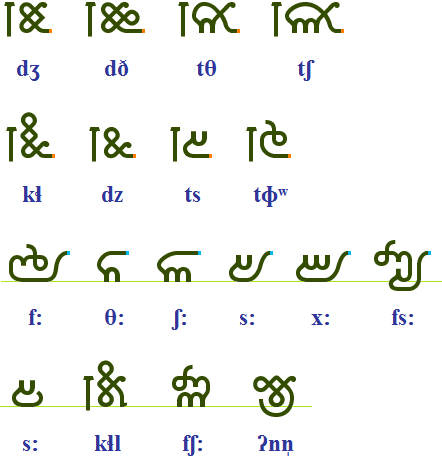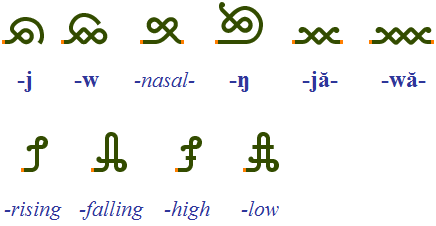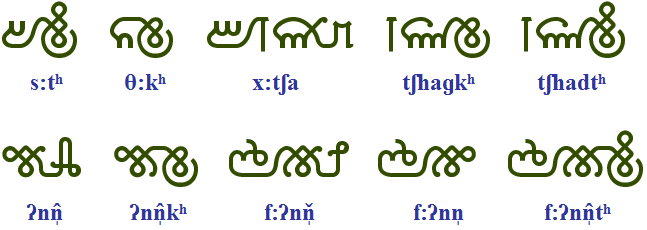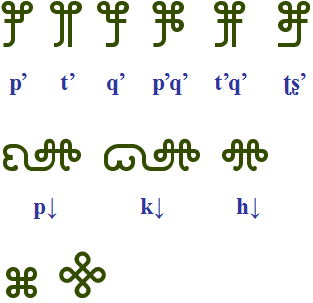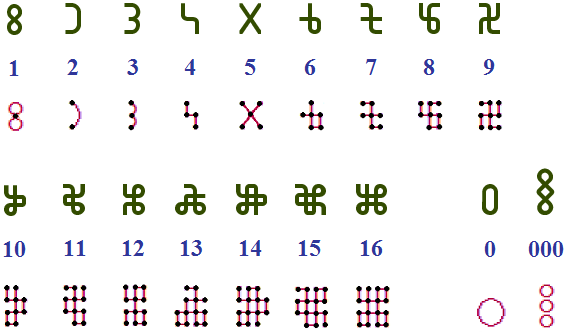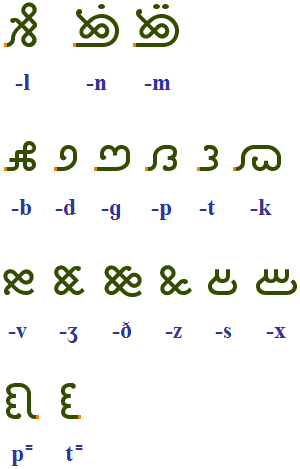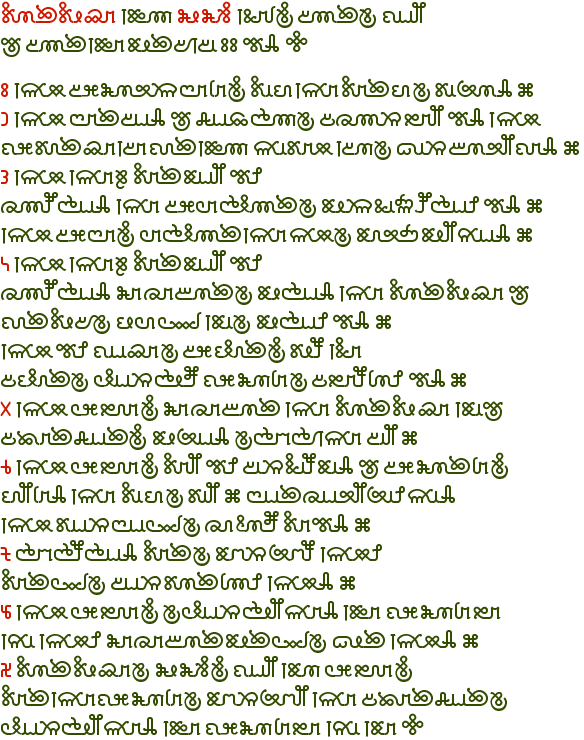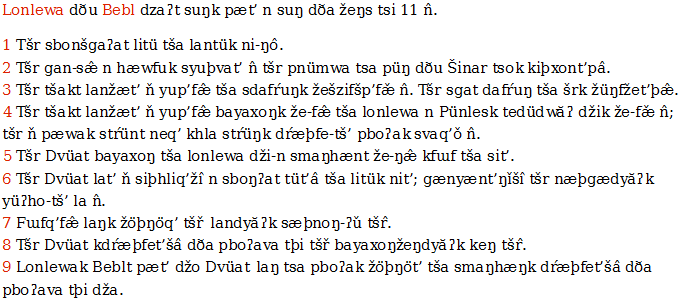This is the 36th version of the SIGIL script, and rendition c of that version (third time lucky). It has many letter forms and ideas coming from version 34c. Compared with other versions of SIGIL script, and the Phonological Cypher series, there is less interest here in strictly maintaining featural relationships based on phonetics. Indeed, whilst it does present a kind of syllabary for root words, it is not so much an alphabet of phoneme sequences as a description of SIGIL’s morphology. (This will become clearer to readers once details of the language are published.) The script includes several families of loops, somewhat reminiscent of the Avoiuli script.
1 Initial Consonants
1.1 Primary consonants
This script is fully cursive, limited by the needs of the grammar; so connectivity was an over-riding demand in the design of each phoneme. Each grammatically defined unit is written with a single stroke of the pen. This can be seen in the syllables of simple words; the name of the language, Sgai, is shown at the top of the page written with two strokes. There is one medial consonant, the flap. (The orange tip shows where the stroke continues, which in most cases is along the baseline.)
1.2 Affricates and special connections
A prefix like a thin T is used before a fricative to signal the arising of an implicit initiating plosive. In almost all cases that will be /d/ or /t/ for voiced and unvoiced fricatives respectively. Some fricatives initiating a grammatical unit connect at the upper-right, at the blue tip. There are four solo letters for special occasions. (Baseline shown in green).
2 Vowels
2.1 Open and medial vowel connections
Vowels may connect medially to the second vowel of a diphthong, to a “nasalizer”, or a suffix consonant (see below). Some vowels have a specifically final form. Schwa is always short, and voiced or unvoiced depending on the voice of the previous consonant; it helps to create sesqui-syllables. The other vowels tend to be long.
2.2 Simple codas and semivowels
If the second vowel in a diphthong is /i/ or /u/ and final, the reversed semivowel letter is used. The nasalizer in practice tends to one of the three nasal consonants depending on sandhi with a following consonant. For example, before /b/ the nasalizer will tend to be pronounced /-m/. If the nasalizer is word-final, it sounds as /-ng/. If there is a suffixed consonant, the medial form is written. There are special vowel sequences featuring short /ja/ and /wa/, which tend to acquire a high creaky tone (and are two of the few glyphs written with two strokes). Explicit tonemarks may be suffixed in some situations.
3 Consonantal finals
3.1 Simple finals
The fricative and glottal finals are simply reversed forms of the initials. Final /t/ and /k/ have special letters.
3.2 Examples of final connections
This shows some typical connections featuring consonantal finals. Note how long fricatives may attach to a following affricate marker. There is a special construction involving an aspirated affricate and a stop. There are several ways that the /nn/ unit may connect to other letters.
4 Non-pulmonic consonants
Ejectives are a distinctive feature of Sgai. For certain unvoiced consonants, an inward airflow can be applied. Inward /h/ is basically an inbreath. Symmetrical loop units may be used to show logical divisions.
5 Numerals
As with all the numeral systems of SIGIL scripts so far, this version’s system is based on joining designated numbers of dots. The main changes from version 34 include ONE and the hexadecimals. A single glyph is used for a set of three zeroes (thousands). Only FIVE, SEVEN and NINE use more than one stroke.
6 Extensions
Unlike previous versions of SIGIL scripts, this one was not designed for transliterating foreign languages like English. But here are some extensions to enable writing a few more phonemic situations, mostly common consonantal codas. Notice how the stops are reversals of initial plosives, and the extra fricatives take solo forms. The unaspirated /p/ and /t/ are for Thai.
7 Examples
Using some of the above extensions, it is possible to transliterate a bit of Shakespeare’s 18th sonnet. The nasal final adapts correctly to each situation, so special glyphs for /m/ and /n/ are not neccesary.
Shall I compare thee to a summerís day?
Thou art more lovely and more temperate
Mattias Persson recommended I should give this script a proper name. So now it may be called Slinseng, which in Sgai means “syllables drawn”:
For an extended example of Sgai, I have produced a translation of Genesis 11, the Tower of Babel text. The transliteration below is not IPA, but uses a set of familiar European letters.
1 And the whole earth was of one language, and of one speech.
2 And it came to pass, as they journeyed from the east, that they found a plain in the land of Shinar; and they dwelt there.
3 And they said one to another, Go to, let us make brick, and burn them thoroughly. And they had brick for stone, and slime had they for mortar.
4 And they said, Go to, let us build us a city, and a tower, whose top may reach unto heaven; and let us make us a name, lest we be scattered abroad upon the face of the whole earth.
5 And the LORD came down to see the city and the tower, which the children of men builded.
6 And the LORD said, Behold, the people is one, and they have all one language; and this they begin to do: and now nothing will be restrained from them, which they have imagined to do.
7 Go to, let us go down, and there confound their language, that they may not understand one another's speech.
8 So the LORD scattered them abroad from thence upon the face of all the earth: and they left off to build the city.
9 Therefore is the name of it called Babel; because the LORD did there confound the language of all the earth: and from thence did the LORD scatter them abroad upon the face of all the earth.
Note about Avoiuli
The Avoiuli alphabet is used by the Turaga people of Pentecost Island (Vanuatu) for writing their language Raga. It is based on patterns used in traditional sand drawings, featuring a set of curly letters written cursively, and a one-to-one match with the Latin letters usually used for writing Raga. This chart of letters was gleaned from David McCreedy’s wonderful Travel Phrases website with help from Mattias Persson. The /ng/ and /k/ were recently revealed at Omniglot, and the primary source is actually the work of linguist Andrew Gray. There is apparently an interesting set of punctuation symbols, but I have seen no details yet.


